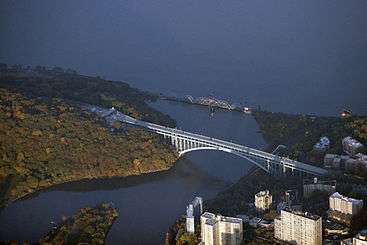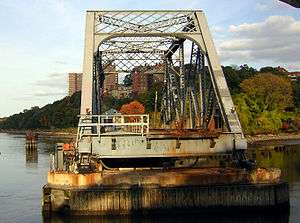Spuyten Duyvil Bridge
Coordinates: 40°52′42″N 73°55′32″W / 40.87833°N 73.92556°W
| Spuyten Duyvil Bridge | |
|---|---|
|
Circle Line boat crossing bridge, 2014 | |
| Carries | Amtrak Empire Corridor (1 track) |
| Crosses | Harlem River |
| Locale | Manhattan and the Bronx, New York City |
| Characteristics | |
| Design | Railroad swing bridge |
| Total length | 610 feet (190 m)[1] |
| Longest span | 286 feet (87 m)[2] |
| Clearance below | 5 feet (1.5 m)[1] |
| History | |
| Opened | 1900 |
The Spuyten Duyvil Bridge is a railroad swing bridge that spans the Spuyten Duyvil Creek between Manhattan and the Bronx, in New York City. The bridge, which carries Amtrak trains traveling along the Empire Corridor, is located at the northern tip of Manhattan where the Spuyten Duyvil Creek meets the Hudson River, approximately 1,000 feet (300 m) to the west of the Henry Hudson Bridge. It was built to carry two tracks but now carries only a single track on the east side of the bridge.[2]
A wooden railroad bridge across the Spuyten Duyvil was first constructed by the New York & Hudson River Railroad in 1849.[3] The current steel bridge was designed by Robert Giles and constructed in 1900; the piers rest on pile foundations in the riverbed.[1][4] Trains stopped running across the bridge in 1982 and the following year the bridge was damaged by a vessel and was left unable to close.[5]
The bridge was rehabilitated in the late 1980s and Amtrak's Empire Service began using the Spuyten Duyvil Bridge on April 7, 1991, following the completion of the Empire Connection. This involved the conversion of the abandoned West Side Line to accommodate passenger service and connect with Pennsylvania Station. Until then, Amtrak trains traveling between New York and Albany had utilized Grand Central Terminal.[1][6][7]
The bridge is used by approximately 30 trains a day and is opened over 1,000 times per year, primarily during the summer months for Circle Line Sightseeing Cruises and recreational vessels.[2]
Incidents
- On the evening of February 16, 2004, an 80-year-old woman mistakenly drove her car onto the bridge from the Bronx side of the river and was hit by a Penn Station-bound Amtrak train. Although the passenger train carried the automobile for a distance of 250 feet (76 m) along the tracks, the woman survived the crash.[8]
- During the early morning hours of October 24, 2010, a fire broke out on the bridge, suspending train service until later that evening.[9][10]
- A boat ran into the bridge at around 4:20pm on May 29, 2016, causing major delays on the Empire Line, as the bridge was required to be inspected before trains could use it again. No injuries were reported in the incident.[11]
Gallery
 An aerial view showing the Henry Hudson Bridge (foreground) and the Spuyten Duyvil Bridge
An aerial view showing the Henry Hudson Bridge (foreground) and the Spuyten Duyvil Bridge A view of the bridge from the south along the Hudson River
A view of the bridge from the south along the Hudson River Spuyten Duyvil The Bronx end of the bridge when the swing is open
Spuyten Duyvil The Bronx end of the bridge when the swing is open
References
Notes
- 1 2 3 4 Gray, Christopher (March 6, 1988). "Spuyten Duyvil Swing Bridge; Restoring a Link In the City's Lifeline". New York Times. Retrieved 2009-07-26.
- 1 2 3 Rolwood, Craig; Ostrovsky, Alex (2004). "Spuyten Duyvil Emergency Response to Navigation Strikes" (PDF). Conference Proceedings. American Railway Engineering and Maintenance-of-Way Association. Retrieved 2011-07-04.
- ↑ Adams, Arthur G. (1996). The Hudson River Guidebook (2nd ed.). New York: Fordham University Press. p. 113. ISBN 0-8232-1680-2.
- ↑ Geological Society of America (1905). Bulletin of the Geological Society of America. 16. Rochester: Geological Society of America. p. 157. Retrieved 2010-03-20.
- ↑ Renner, James (March 2001). "Spuyten Duyvil Swing Bridge". Washington Heights & Inwood Online. Archived from the original on January 6, 2006. Retrieved 2010-02-07.
- ↑ Johnson, Kirk (July 7, 1988). "Amtrak Trains To Stop Using Grand Central". The New York Times. Retrieved 2009-07-26.
- ↑ Staff (April 7, 1991). "Travel Advisory; Grand Central Trains Rerouted To Penn Station". The New York Times. Retrieved 2009-07-26.
- ↑ Sclafani, Tony & Standora, Leo (February 17, 2004). "Amtrak Hits Car Driving on Tracks". Daily News. New York. Archived from the original on August 15, 2011. Retrieved 2013-02-06.
- ↑ "Spuyten Duyvil Bridge Burned Over Weekend". The Riverdale Press. October 25, 2010. Retrieved 2011-07-03.
- ↑ Anderson, Eric (October 24, 2010). "Amtrak Service to NYC Restored". Times Union. Albany. Retrieved 2011-07-03.
- ↑ Zauderer, Alyssa (May 29, 2016) "Amtrak service on Empire Line suspended after boat strikes Spuyten Duyvil Bridge" WPIX 11 News
External links
| Wikimedia Commons has media related to Spuyten Duyvil Bridge. |
